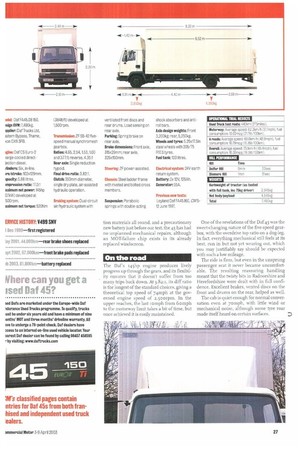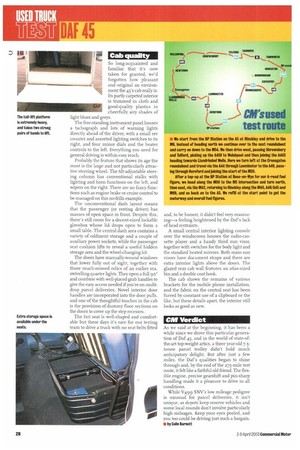D he ancestors of today's Daf LF45 have been a
Page 26

Page 27

Page 28

If you've noticed an error in this article please click here to report it so we can fix it.
staple part of the UK's light haulage scene throughout this tester's life and career. From the B MC FG range, with its still-unique 'thrupenny bit' cab, and then the Leyland
Terrier with its tilt cab, the line moved into the modem world with the Leyland Roadrunner. This soon made a name for itself in the early eighties, and not just for its unusual glazed grille panel (or the two-wheeled exploits at its launch!), but as a solidly dependable 7.5-tonne workhorse. What remained fundamentally the same product continued to evolve into the Daf 45 and stayed at, or near, the top of the best-seller chart until it was replaced by the current LF45 range.
Product low-down
Buying a Daf 45 7.5-tonner came with a fair selection of decisions to be made. Seven wheelbases range from 3,25omm to 5,5oomm, and each has a choice of day or sleeper cab. Whichever cab you chose, there was a further choice between 132 or 145hp Euro-2 six-cylinder Cummins engines, although the only transmission offered was ZF's evergreen S5-42 five-speed synchro unit.
An extensive options list included an exhaust brake, PTO, rear air suspension, ABS and alternative front axle ratings, final-drive ratios and fuel tanks.
At 4,400mm, our test subject sits on the middle wheelbase, has the day cab and is powered by the 145hp engine. Literally one of the very last trucks of the nineties, and no doubt satisfying someone's end-of-millennium sales targets, V499 SNV first appeared on the DVLA database on 30 December 1999. Since then, it has covered just 8r,000ktn. Its owner was the Initial Citylink parcels franchise based at Milton Keynes, although for much of its life it operated out of Aylesbury.
V499 SNV is fitted with a zift box body by Newland Commercials, complete with roller shutter rear closure and waist-height restraint rail. The cab has a roof deflector fitted, although it would be more useful if it were bigger. Apart from a bit of delamination of the resin-coated ply floor at the very rear, the body is in good shape. Our only concern in daily use would be the weight of the DEL Super Loader tail-lift, which really needs two strong pairs of hands to unfold and stow the steel-loading platform.
The green Initial Citylink livery has been restored to its original white with a decent respray, although a bit more attention to the wheels, side bars and tail-lift would have given it more concours points. A bit of over-exuberant pressure washing has put some moisture into the headlamps and destroyed the little foam filter pad for the cab's fresh-air intake, but neither should be a significant problem.
Our test truck was offered for sale at o,7oo , (a fiver more than the CAP retail price for a 2 oo,00 okrn example). According to CAP's heavy commercial vehicle editor, Barrie Travis, the 7.5-tonne market is still in a state of over-supply across all the principal marques.
This is especially true of boxvans, where an extra f9 oo could be achieved by cutting down a boxvan and converting it to a dropside for operations such as scaffold transport. If you fancy this particular truck, you're too late, as its low mileage led to it being snapped up by a private buyer on behalf of a charity.
Bottom line
Given that Daf 45s have traditionally produced outstanding fuel consumption figures, V499 S NV's overall result of 15.30mpg was a bit less than we would have expected. This was almost entirely down to the 13.02mpg recorded on the motorway section, not helped by some pretty forceful headwind gusts, particularly on the M42 and M4o south of Birmingham. On the A-roads, its performance was much closer to what we have come to expect, at I6.79mpg.
Journey times were fine, though, and could have been even better if we'd chosen to stir the gearbox harder, rather than taking the lazier option of letting the engine's flexible nature take some of the stress.
At over 4,5 ookg, the 45's body/payload potential is at the higher end of the scale as 7.5-tonners go, although that sturdy tail-lift is going to cost a few parcels. A decent amount of spare axle capacity should be handy for the diminishing loads of parcel distribution.
Apart from new brake fric tion materials all round, and a precautionary new battery just before our test, the 45 has had no unplanned mechanical repairs, although an MOT-failure chip exists in its already replaced windscreen.
On the road
The Dal's 145hp engine produces lively progress up through the gears, and its flexibility ensures that it doesn't suffer from too many trips back down. At 3.82:1, its diff ratio is the longest of the standard choices, giving a theoretical top speed of 74mph at the governed engine speed of 2,500rpm. In the upper reaches, the last Tomph from Gomph to the motorway limit takes a bit of time, but once achieved it is easily maintained.
One of the revelations of the Daf 45 was the sweet-changing nature of the five-speed gearbox, with the overdrive top ratio on a dog-leg. In fact. everything mechanical still feels at its best, run in but not yet wearing out, which you may justifiably say should be expected with such a low mileage.
The ride is firm, but even in the unsprung passenger seat it never became uncomfortable. The resulting reassuring handling meant that the twisty bits in Radnorshire and Herefordshire were dealt with in full confidence. Excellent brakes, vented discs on the front and drums on the rear, helped as well.
The cab is quiet enough for nonnal conversation even at 7o mph, with little wind or mechanical noise, although some tyre roar made itself heard on certain surfaces.
Cab quality
So long-acquainted and familiar that its now taken for granted, we'd forgotten how pleasant and original an environment the 45's cab really is. Its partly carpeted interior is trimmed in cloth and good-quality plastics in cheerfully airy shades of light blues and greys.
The free-standing instrument panel houses a tachograph and lots of warning lights directly ahead of the driver, with a small rev counter and assorted lighting switches to its right, and four minor dials and the heater controls to the left. Everything you need for general driving is within easy reach.
Probably the feature that shows its age the most is the large and not particularly attractive steering wheel. The tilt-adjustable steering column has conventional stalks with lighting and horn functions on the left, and wipers on the right. There are no fancy functions such as engine brake or cruise control to be managed on this no-frills example.
The unconventional dash layout means that the passenger (or resting driver) has masses of open space in front. Despite this, there's still room for a decent-sized lockable glovebox whose lid drops open to form a small table. The central dash area contains a variety of oddment storage and a couple of auxiliary power sockets, while the passenger seat cushion lifts to reveal a useful bidden storage area and the wheel-changing kit.
The doors have manually-wound windows that lower fully out of sight, together with those much-missed relics of an earlier era, swivelling quarter lights. They open a full 90° and combine with well-placed grab handles to give the easy access needed if you're on multidrop parcel deliveries. Novel interior door handles are incorporated into the door pulls, and one of the thoughtful touches in the cab is the provision of dummy floor sections on the doors to cover up the step recesses.
The Isri seat is well-shaped and comfortable but these days it's rare for our testing team to drive a truck with no seat belts fitted and, to be honest, it didn't feel very reassuring—a feeling heightened by the Dars lack of head restraints.
A small central interior lighting console over the windscreen houses the radio-cassette player and a handy third sun visor, together with switches for the body light and the standard heated mirrors. Both main sun visors have document straps and there are extra interior lights above the doors. The glazed rear cab wall features an atlas-sized bin and a double coat hook.
The cab shows the remains of various brackets for the mobile phone installation, and the fabric on the central seat has been furred by constant use of a clipboard or the like, but these details apart, the interior still looks as good as new.
CM Verdict
As we said at the beginning, it has been a while since we drove this particular generation of Daf 45, and in the world of state-ofthe-art top-weight artics, a three year-old 7.5tonne parcel trolley didn't hold much anticipatory delight. But after just a few miles, the Daf's qualities began to shine through and, by the end of the 275-mile test route, it felt like a faithful old friend. The flexible engine, precise gearshift and pin-sharp handling made it a pleasure to drive in all conditions.
While V499 S NV's low mileage pedigree is unusual for parcel deliveries, it isn't unique, as depots keep reserve vehicles and some local rounds don't involve particularly high mileages. Keep your eyes peeled, and you too could be driving just such a bargain.
by Cohn Barnett
































































































































































